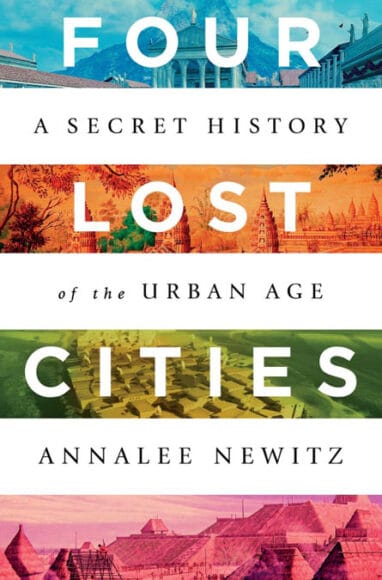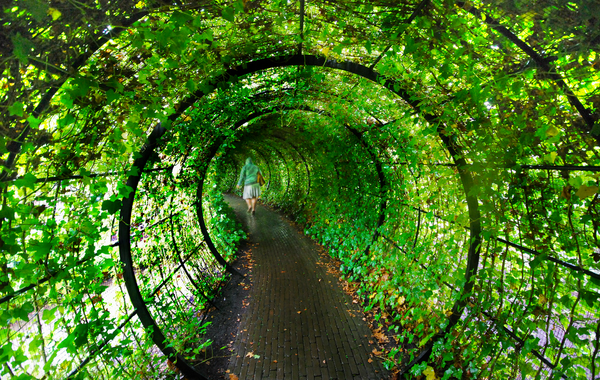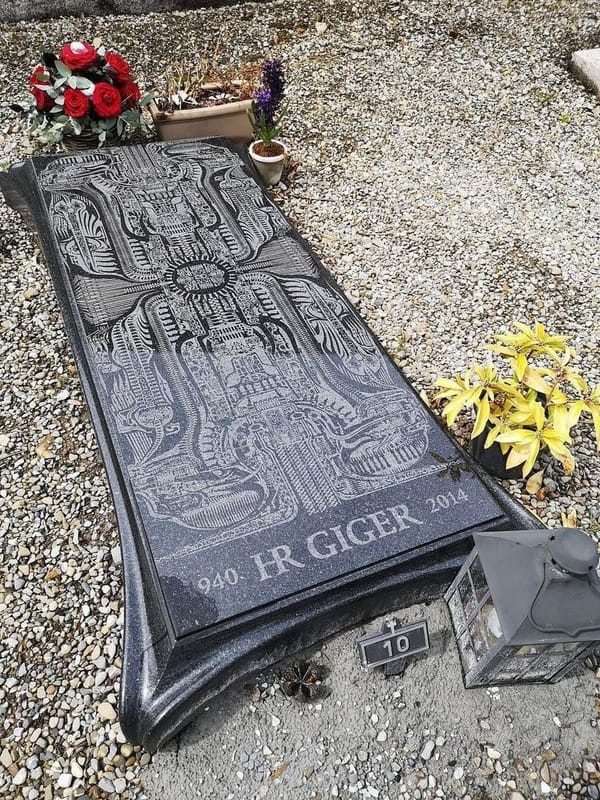Book of the Month: FOUR LOST CITIES by Annalee Newitz
Let's dig up some history, shall we?

What images come to mind when you hear the phrase "lost city"? Your imagination likely conjures up crumbling stone ruins overrun by jungle foliage or buried beneath desert sands, left uninhabited for hundreds or even thousands of years. There might even be traps guarding mystical secrets or hidden treasure, depending on whether you're thinking of the real world or the land of fiction.
This is indeed the classic image of a lost city invented by early archaeologists and perpetuated by pop culture, but it's an image with deep flaws. It often excludes the city-builders themselves, erasing the perspectives of ordinary people who called the place home before its abandonment—if it even was abandoned, since many famous "lost" cities were still inhabited by locals when European explorers "discovered" them. But a dead city is much easier to steal artifacts from than a living one.
Simply put, the traditional lost city is at its core an imperialist myth, one that has been thoroughly debunked by the archaeologists of today. But if the stories we've been told about these places are not true, then what are the true facts behind them? What have modern archaeologists learned by excavating the urban centers of once-powerful societies? And what lessons can the cities of today learn from the decline of their predecessors?
In the book Four Lost Cities: A Secret History of the Urban Age, author Annalee Newitz sets out to find the answers to those very questions. Newitz is both a science-fiction writer and a science journalist; their body of work ranges from futuristic novels to articles for magazines like Popular Science and Wired to founding the science/sci-fi blog io9. Looking at those credentials, you might be confused as to why Newitz would write a book on history and archaeology. Why would a person who's spent their career writing about humanity's possible futures suddenly switch gears to focus on its past?
The real question is, why wouldn't they? The problems facing major cities today—political strife, economic inequality, climate disasters and many others—are not modern inventions. Our city-dwelling ancestors have had to confront those issues for as long as cities have existed. By studying how their urban centers rose and fell, Newitz writes, we have a greater chance of changing our cities' futures for the better.
The titular four lost cities are scattered across three continents, and their histories stretch from 7000 BCE to the 15th and 16th centuries. First we encounter the cramped "proto-city" of Çatalhöyük, a Neolithic site in modern-day Turkey. Then we're off to explore the ruins of Pompeii, the Roman resort town infamously obliterated by Mount Vesuvius in 79 CE. After that, we journey into the Cambodian jungle to learn about life in Angkor, the capital of the Khmer Empire for over six hundred years. Finally we visit the mounds of Cahokia, the heart of Mississippian culture in what is now the Central US. In every location, Newitz consults with archaeologists who have been studying the site for years or even decades. And every time, they seek answers to the same basic questions: how did this city come to be, what purpose did it serve for its inhabitants, and what factors eventually made the city unable to serve that purpose?
The history of each city tells a unique and thought-provoking story about urban development across centuries. Çatalhöyük, for example, shows us the tribulations of humans experimenting with urban life for the first time. People who had grown up as nomads or residents of small villages found themselves participating in survival and social interaction on a scale never seen in human history before. A greater population meant the ability to grow more food and develop specialized trades, but conflict resolution became a greater and more important challenge with everyone physically tied to the same settlement. Pompeii, meanwhile, shows archaeological evidence of an established urban system and social structure undergoing dramatic changes. It was a place where women could become entrepreneurs and property owners, where former slaves could set up homes and shops in villas that had once belonged to their masters. It also presents a unique scenario for the archaeologists excavating its ruins: what happens when a city's residents do not abandon their home, but are instead forced out by disaster? Angkor tells the story of a sprawling jungle city where kings commanded their subjects to build massive reservoirs as a display of political power, and how the flaws of those very reservoirs may have contributed to the city's decline. And Cahokia challenges modern ideas about what a city can mean to its residents; rather than being an economic hub or the seat of political/military power, archaeological evidence suggests that it was the center of a spiritual and cultural movement amongst the Mississippian people.
The four main sections of the book follow a distinct pattern: the first and second chapters on each city chronicle its rise to prominence and what we know about how its citizens lived, while the third chapter details the factors that triggered its period of decline. If you're reading a print or ebook version of the text, each new section is also accompanied by a map detailing the city's points of interest. Although it's a short text, Four Lost Cities is packed with fascinating anecdotes and tales of exciting archaeological knowledge. You'll learn how people at Çatalhöyük buried their dead under their own beds and carried symbolic stamps as a form of identifying themselves, or how the Mississippians at Cahokia held public ceremonies in a plaza the size of thirty-eight modern football fields. The archaeologists interviewed by Newitz explain in detail how updated historical knowledge and cutting-edge technology have helped them dispel imperialist myths about how these cities rose and fell. This is especially relevant in the Angkor section, which was my favorite part of the book. For example, Newitz describes how early Western archaeologists mistakenly believed that the walled stone temples of Angkor Wat and Angkor Thom were cities themselves. Because their only points of reference came from European styles of city-building, they did not realize that the structures were part of a larger settlement. So when the archaeologists found temple inscriptions claiming that Angkor supported a population of one million people, they scoffed at the idea. But the archaeologists of today have used laser imaging on a large scale to demonstrate that Angkor was more than just those stone temples: it was a massive wooden city built out of the jungle using methods like controlled forest fires and swamp draining. Once the city's infrastructure was no longer being maintained, the wooden buildings rotted away, leaving no trace except
But the book takes on a more somber and warning tone when discussing how these cities lost their residents. As diverse as the four cities are, the factors which gradually brought them down are eerily similar. Newitz identifies several key issues which echo across millenia and plague our societies to this day: climate disasters, political instability and economic inequality. City-dwellers of the past gradually had more trouble acquiring the resources they needed to survive. They faced not only droughts and floods, but tension between social classes and the consequences of their leaders' political mistakes. For many people, the challenges of city life finally outweighed the benefits, causing them to seek homes elsewhere.
Could modern human society be facing another transitional period in the future? Newitz seems to think so. In the epilogue of the book, they give some predictions about what might happen to modern cities if they continue on their current trajectory of mismanagement and negligence. Though their thoughts are ultimately just speculation, they still paint a grim picture of the future. They write that "as more cities become unlivable, people will die. The number of people who perish in floods, fires and pandemics will swell beyond anything we've seen before, and scenes of broken cities littered with bodies will become commonplace." They speculate that those who survive will disperse back into small isolated towns, and some might even regress back into the nomadic lifestyle of their Neolithic ancestors.
But these ruminations on humanity's possible future are not the main thing I will remember about Four Lost Cities, and I doubt that other readers will remember it well, either. The parts I will remember most are those that inspire hope and wonder in the reader. I'll remember the descriptions of how the Roman government stepped in to provide disaster relief after the destruction of Pompeii, helping survivors move to nearby cities and rebuild their lives. I'll remember how working-class Khmer people began to repair the infrastructure of Angkor after the royal family abandoned the city. Even as Cahokia splintered into a web of villages, spirituality and community remained central to Mississippian culture. Just because these ancient people left their homes behind doesn't mean their societies and cultures were lost as well.
In the year 2025, it's become all too easy to embrace what's known online as the "doomer" mentality—the belief that modern society is currently hurtling off the proverbial cliff into an endless age of tyranny, barbarism and suffering, if our species doesn't just wipe itself out in the next few years. With the constant barrage of horrible information our brains receive from social media and the 24-hour news cycle, thinking this way can seem alluring or even logical to a depressed, overwhelmed mind. But it's not healthy or rational, and people have ways to inoculate themselves against it. The most effective one that I've found is studying the past.
Four Lost Cities is a book that provides some much-needed perspective on the history of humanity. Not only will you gain new insight into how ancient civilizations rose and fell, but you'll also feel a greater connection to the people who lived in those civilizations and the impact they left on the world. The book demonstrates that as long as human society has existed, settlements and political entities have gone through cycles of ascension and decline. The people of the past made the same mistakes that we are making today, and while they faced consequences for those mistakes, they also displayed remarkable resilience against the forces which ate away at their cities. The Khmer people still exist, for example; they were even living in Angkor when it was "discovered" by European explorers. Even the cultural practices of the Mississippian people have survived to the present through several Native American tribes.
History teaches us that we are but a few threads in the massive, millenia-old tapestry that is human civilization. Some urban experiments may have ultimately failed, and some groups found themselves changing their ways of life in order to survive periods of turmoil. But humans build new experiments on the foundations of their old ones, adpating to new circumstances while preserving communal memories of the people who came before them. And sometimes, they even learn from their mistakes.
This has been the Book of the Month for July. Thank you for reading, and please check back here in August to read about my next book selection!
—Dana




